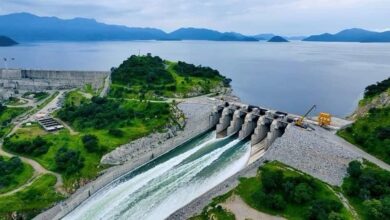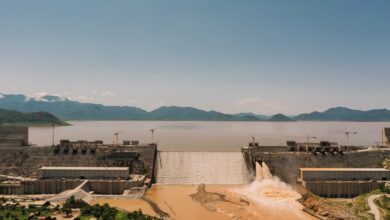
The Ministry of Irrigation and Water Resources in Egypt issued a statement on Monday accusing Ethiopia of actively seeking to impose a de facto situation on the two downstream countries by filling the Grand Ethiopian Renaissance Dam (GERD) reservoir for the second year, despite the dam not being ready for the planned electricity generation.
The Egyptian Ministry of Water Resources and Irrigation shed light on several “fallacies” after Ethiopia opened the Bottom Outlet in GERD, in preparation for draining the central part of the dam to start ramping up work to implement the filling process for the second year.
The ministry responded in its statement with seven points of clarification:
-Ethiopia’s claim that the bottom outlets (two vents) are capable of passing the average discharges of the Blue Nile is incorrect as the current capacity for discharge does not exceed 50 million m3/day for both vents, which does not meet the needs of the downstream countries and doesn’t match the average behavior of the Blue Nile.
-The second filling process this year and retaining large quantities of water, according to what was announced by the Ethiopian side, will greatly impact the river system because the only limitations in place during the filling process for quantities of water discharged from the dam will be these two bottom outlets. The situation will be more complicated starting from the flood season in July because the vents will release a lower discharge than usual received in July and August.
The statement explained that the maximum discharge of the bottom outlets is estimated at three billion cubic meters per month, assuming that the level of 595 meters is reached, which will cause Sudan and Egypt to suffer in the event of a moderate flood and even worse during a low flood.
This issue greatly stresses the need to reach a binding legal agreement that includes a clear coordination mechanism.
-Egypt had previously demanded in 2012 and 2015 that these vents be modified to meet the needs of the two downstream countries.
It offered to finance the excess cost and grant greater flexibility during filling and operations while also dealing with various cases of floods and droughts, however Ethiopia claimed that these vents are sufficient and can also operate continuously in the event of a power outage.
-During the first filling process, Ethiopia was supposed to generate electricity through its early generation units (two turbines), but it carried out the first filling and storage of water without generating electricity, which confirms that the first filling process was carried out for propaganda and political reasons, not for technical reasons.
-The outlets of the thirteen turbines are not currently ready for operation, and therefore the generation of electricity to the degree promoted by Ethiopia is incorrect. There is a strong correlation between the readiness of the turbines for generation and the amount of stored water, but Ethiopia is racing against time to impose a de facto situation on the two downstream countries through filling the dam’s lake for the second year despite the dam not being ready for the planned electrical generation.
-Ethiopia’s claim that the GERD conforms with international specifications is also incorrect as Ethiopia is building the dam improperly.
Issues include changes in the auxiliary dam, changing the level of turbine outlets, removing three turbine exits after their installation, reducing the number of turbines from 16 to 13, not pouring concrete in the different parts of the dam in a homogeneous manner.
This has raised suspicions of corruption, an issue which has previously caused the project to stop more than once.
-Technical problems are known to occur during the trial operation of these vents or early turbines (two turbines) – if the Ethiopian side managed to operate them – which will greatly impact the water flows to the downstream countries.


